Among the places visited by Nicholas Roerich during his Asian expeditions in the 20s, a special mention goes to the area of the Altai Mountains, where the Russian painter and explorer went in search of the mythical Belovodye, underground "Land of the Immortals" equivalent to Himalayan Shamballah, where according to legend the mysterious Chud lineage was hidden in an antediluvian past, and from which it is believed that in the near future the holy Oirot Khan, last descendant of Genghis Khan and "Savior of the World", will come.
di Vincent Pisciunieri
Adapted from Roerich's mission in Asia - Shamballah
Cover: Nicholas Roerich, The Rite of Spring
THE ALTAI MOUNTAINS
Partly in Soviet territory and partly in Mongolia, the range of the Altai Mountains extends from the southeast of western Siberia forming the northern border of the Gobi. The territory of the Altai Mountains is the axial region of the Eurasian continent, where the forests in the southwest of Siberia are in contact with the great steppes and deserts of Central Asia and where the borders of the four major countries: Russia, Kazakhstan, China and Mongolia. In terms of geopolitics, the region is the political center, the heart of Eurasia. From the glaciers of the Altai mountains there are four great rivers, Irtys, Ob, Yenisei, Hovd, Canas, which provide water for many millions of people living in Russia, Kazakhstan, China and Mongolia. The rich and black earth, the crisp mountain air, the sources of pristine waters, the unique forest resources, where there are precious conifers, pine forests, herbs and berries, large quantities of healing clays, make the region the lung of Eurasia.
The Altai Mountains were to be the place of the New Russia called Zvenigorod by the Masters, a new nation in Asia, the Sacred Union of the East. Zvenigorod of the Altai, not the one in Russia, was destined to be a place for the future center of culture, for which it had everything: wealth and nature, fertile land and a beauty never seen before. Zvenigorod, the City of Bells, the utopian city of Roerich located in the Upper Uimon valley at the foot of the sacred Belukha mountain; in Helena Roerich's diaries, Zvenigorod is often called "City of Knowledge". The strategic importance of this stage can be inferred from the fact that in the Altai mountains the members of the inner group SG and MM Lichtmann reached the Roerichs and then returned to America.

Tradition considers the Altai mountains to be sacred, especially the Mount Belukha which stands in the center of the Katun camp. Roerich painted Mount Belukha in 1925, as a backdrop to the Holy Oirot [1], the Messenger of the White Burkhan, depicted on a white horse on a full moon night.
In 1904, a girl had a vision: a white dressed knight appeared to her, riding a white horse, announcing to him the return of Oirot Khan, the last descendant of Genghis Khan, to end Tsarist oppression and restore the ancient empire of the Mongols. This Altai tradition known as the "White faith" - venerates a specific manifestation of the Buddha, known as the Burkhan, a term that in Mongolian Lamaism indicates "divinity". White Burkhan, Oirot, "Messenger", is the name given by the people of Altai al Savior of the World. Khan Oirot, according to Mongolian legend was the last descendant of Genghis Khan and the last ruler of his empire, made a promise to return when Mount Belukha changed shape. In 1904, the year of the vision, the sun destroyed a block of ice and the Belukha peaks changed shape.
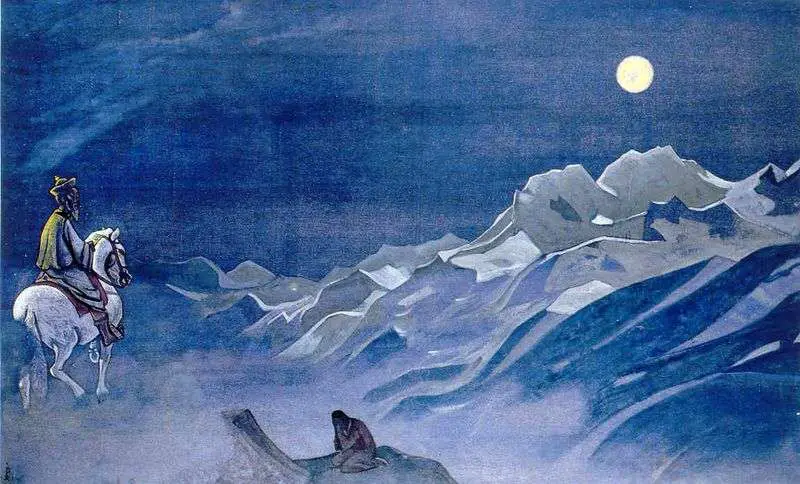
Roerich painted the sacred mountain Belukha several times seen as the counterpart, the twin of Mount Kailash, the holiest of the Himalayan peaks in Tibet. Altai-Himalaya - two magnets, two pressures, two pillars, so wrote Roerich. Mount Belukha is called Uch-Syure, Uch-Orion, Syure - abode of the gods, called Sumer in Mongolia and SuMeru in India. Uch means three, Uch-Orion is associated with the three stars of the belt of Orione. Legends indicate three specific stars, who sent the stone for peace, Cintamani. These are the stars of the Orion belt.
Some Russian traditions speak of a secret place, where men prefer to live as Hermits, indifferent to the passage of time. They reside in caves from which the White Waters arise, near the Altai Mountains. In August 1.926, Nicholas Roerich in his book "Altai-Himalaya" wrote:
“The water of the Ak-Keme river is milky white […] Belovodye […] the Ak-Keme river is at the fiftieth degree of latitude […] the Belukha the blue mountains. Flowers and the green of the grass and cedars are relaxing. Who said Altai is hard and inaccessible? [...] Zvenigorod "
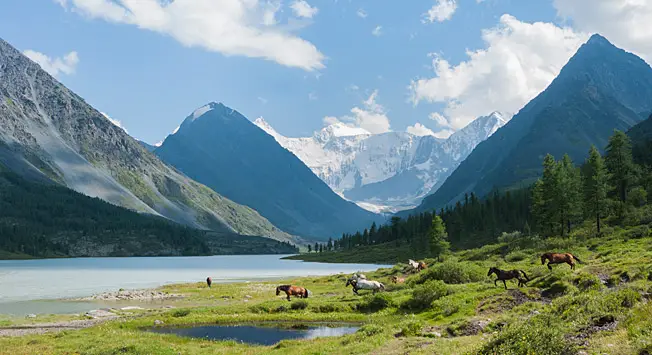
Because N. Roerich hints at the fiftieth degree of latitude? Because in the Altai he wished to found the City of Knowledge, Zvenigorod. The reference on the site where to found a spiritual community is logically found in the book "Community". Suppose that in a certain place you want to found a community. Even if the site meets all the requirements, the surrounding conditions can be temporarily very dangerous. We then turn to another place, to which the possibilities of the first are transferred. In conscience, the opportunities offered by that have not been abandoned, and the effect of the first decision is experienced by laying the foundations for the future structure. Whether something has to be on the fiftieth parallel, or twenty degrees further south, the essential thing is that construction activity remains bright.
Stonehenge, and example is placed at the 50th parallel. If we consider the angle at which the sun's rays fall on the surface of the earth at the summer solstice at a latitude of 50 °? This angle is approximately 63 ° 26 '. The tangent of the angle that the solar rays form with the surface is: tan63 ° 26 '= 2,0. That is, the length of the shadow cast by a peg, at noon, is twice as short as the height of the peg, which casts the shadow. Sunlight constructs during the solstice a rectangle with double height compared to the base, that is a golden rectangle, the harmony of the divine proportion. In addition to the harmony of light there is that of the surrounding nature in the form of alpine meadows of herbs and plants, pure atmosphere, the mountain prana, with streams coming from the snows of the mountains and glaciers. A place full of meteoric dust, here as elsewhere there should be a harmony of space - the harmony of the spheres. In that place, the most complete harmony was achieved between the currents of the Earth with the Fire coming from space.
We know that the dream of the founding of the City of Knowledge in the Altai could not come true, due to the dullness of the Soviet rulers who were preparing to implement repression plans and that therefore the Citadel of Knowledge was built in Kullu, with the Urusvati Institute. . Let us now consider the location of the Urusvati Institute in the Kullu Valley. It is located at a latitude of approximately 31 ° 44 '. We construct a triangle formed by the incident rays of the sun and the shadow cast by a peg on the earth during the equinox, we calculate that the tangent is: tan31 ° 44 '= 0,618. That is, the length of the shadow cast by a peg on the day of the equinox is 0,618 of its height. The ratio between the sides of the rectangle is 0.618 = Φ and this is the value of the divine proportion, the Golden Section [2].
.
Altai has played a very important part in the migration of peoples and is an intact treasure with Mount Belukha, the ruler, of all rivers and fields, ready to surrender its riches. At the Altai Mountains, N. Roerich learned that the foothills of the Himalayas concealed entrances that led to deep chambers, where mysterious artifacts and exotic treasures had been deposited since the dawn of time. Roerich saw many caves containing carved bones and inscriptions. Lacking a light to measure depth, Roerich did not continue further but it was certain those caves conceal the same secret passages used to reach Tibet, Kunlun, Altyn-Tag, Turfan, and other places. In the Altai mountains, they are found burial places marked with inscriptions on the rocks, made by forgotten peoples. Roerich says the whole area is a powerful and sacred magnet for the future. Roerich, in Shamballa, the resplendent, writes of a mysterious people, the Chud, who, to escape the tyranny of the White Tsar, one day preferred to disappear into an underground kingdom, through an entrance located in the Altai Mountains. Roerich wrote that the stones surrounding his entrance resembled the enormous ones of other tombs he had seen referring to the period of the great migrations in places such as the foothills of the North Caucasus.
The new Altai Republic, despite its meager finances, wanted to order a monument of two tons of Ural marble to N. Roerich, for his work carried out. The bust of Roerich it was placed so that the Altai mountains can be seen in the background.
Right: marble statue of N. Roerich, in the Siberian Altai
BELOVODYE - THE LAND OF THE LIVING GODS
From Tibet through the Kunlun, through the Altyn-Tag and the Turfan; "The long ear" knows the secret passages. How many people have been in these tunnels and caverns. The folk tradition of ancient Russia describes a place located in the heart of Asia, called Belovodye in Russian - Belovodye means white water. […] In the middle of the XNUMXth century, extraordinary news was brought to the Old Believer: “In distant countries, for the Great Lakes, beyond the high mountains, there is a sacred place where justice flourishes. There dwells higher knowledge, the highest form of wisdom destined to save the entire future of humanity. This place is called Belovodye. "
[3]
An article with the title appears in the annual Journal of the Russian Geographical Society of 1903 The journey of the Ural Cossacks to the Kingdom of Belovodye, written by an explorer who goes by the name of Korolenko. Similarly, in October 1916 the Geographical Society of Western Siberia published an account by the Russian historian Belosliudov, entitled The story of Belovodye. As published by scientific institutes, both articles are of considerable interest, as they reveal a strong tradition that still exists among the "old believers" of Russia, according to which Belovodye is a secret place existing somewhere in the area of southwestern Siberia. , in practice on the Altai Mountains described by Roerich.
In 1893 in a manuscript at the hermitage of Vyshenski-Uspenski, near Shatsk, Province of Tambov, a testimony dating back to the previous millennium was found: “The Saga of Belovodye”. The story appeared in the April 4, 1949 edition of Novaya Zarya (“New Dawn”), a Russian newspaper in San Francisco. It reports the account of a young Slavic monk, this Sergius, who spent several years in a monastery on Mount Athos, in northern Greece, near the Aegean Sea. The poor state of health of his father forced him to return to Kiev and some time after his arrival Sergius, then almost thirty years old, obtained an audience from Prince Vladimir the Great (956-1015). He intended to report to the prince what he had learned in the monastery library about a mystery girl "Land of the East where virtue and justice reigned" (“The Belovodye Saga”, Novaya Zarya, ibid.). The prince was so fascinated by the history of the legendary district that in 987 he appointed Sergius at the head of a substantial expeditionary force, which he equipped and sent in search of the wonderful Asian land. The prince's advisers estimated that the 6.000-mile (9.660-kilometer) journey would take a total of three years, yet several years passed without any news of the expedition. In Kiev it was believed that all its members had perished; however, in 1043 a man arrived in the city who claimed to be the monk Sergius, sent about 56 years earlier by Prince Vladimir the Great in search of the Valley of the Immortals.
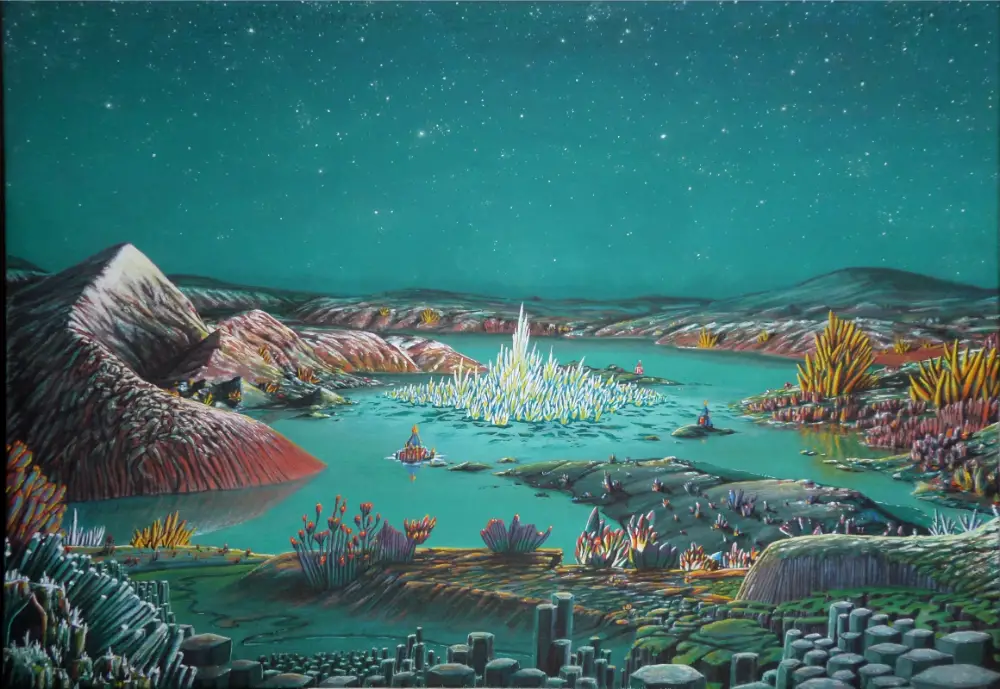
The substance of his account was duly noted and preserved with the mystics of a Russian monastery; this is the document found in 1893. Father Sergius reported that at the end of the second year of their arduous journey many men and animals of the expeditionary force had died, due to the extreme climatic conditions or the attack of wolves and bears. In a desolate territory the group, stumbled upon a pile of skeletons of humans, horses, camels and donkeys, being so terrified of it that he refuses to go any further. Only two members of the expedition agreed to continue with Sergius, only to be left in a village at the end of the third year, due to their poor health. Father Sergius himself had reached the limit of endurance, yet he was determined to complete the journey or perish. From the populations of the various regions crossed he had heard rumors indicating that the fabulous district of Shambhala he really existed and that he was moving in the right direction. He hired another guide, who assured him that he would lead him close to the Holy Kingdom, which the local people called "The Forbidden Land [...] the Land of the Living Gods and the Land of Wonders" (“The Belovodye Saga”, ibid.).
Three months later, Father Sergius reached the borders of Shambhala. At one point the only remaining guide refused to proceed further, terrified by him invisible guardians of the snow-capped mountains. Sergius was still indifferent to death and very confident in the existence of the community of holy men he had set out to find; besides, he was too exhausted to go back. After a few more days of walking, he was suddenly approached by two foreigners, who managed to make themselves understood despite speaking an unknown language. Then Sergius was taken to a village where, after recovering his strength, he was entrusted with the task of collating manuscripts in a monastic environment. He was later transferred to an underground cave, illuminated by a peculiar light that aroused his amazement, which "illuminated everything, dispelling darkness and shadows, so that everything appeared uniform and delicate" (“The Belovodye Saga”, ibid.). Then he was moved to a nearby place where he was welcomed as a brother.
As the months and years passed, the Slav monk acquired great knowledge of a spiritual nature; he was deeply gratified to have finally found tolerant, compassionate, all-seeing and wise individuals who worked for the good of humanity. He learned that, invisibly, they watched everything that was happening in the outside world, alarmed by the forces of evil growing on Earth. Father Sergius also learned that numerous individuals from various countries had unsuccessfully attempted to enter this territory. The inhabitants observed a strict law under which only seven people each century were allowed to visit their home. Six of these would return to the outside world with secret knowledge, while one would remain to live in Shambhala without growing old, as the time of his genetic clock would stand still. Before returning to Kiev, Father Sergius spent his final years teaching wisdom in a network of caves, later elaborated in the Monastery of the Caves. [4]
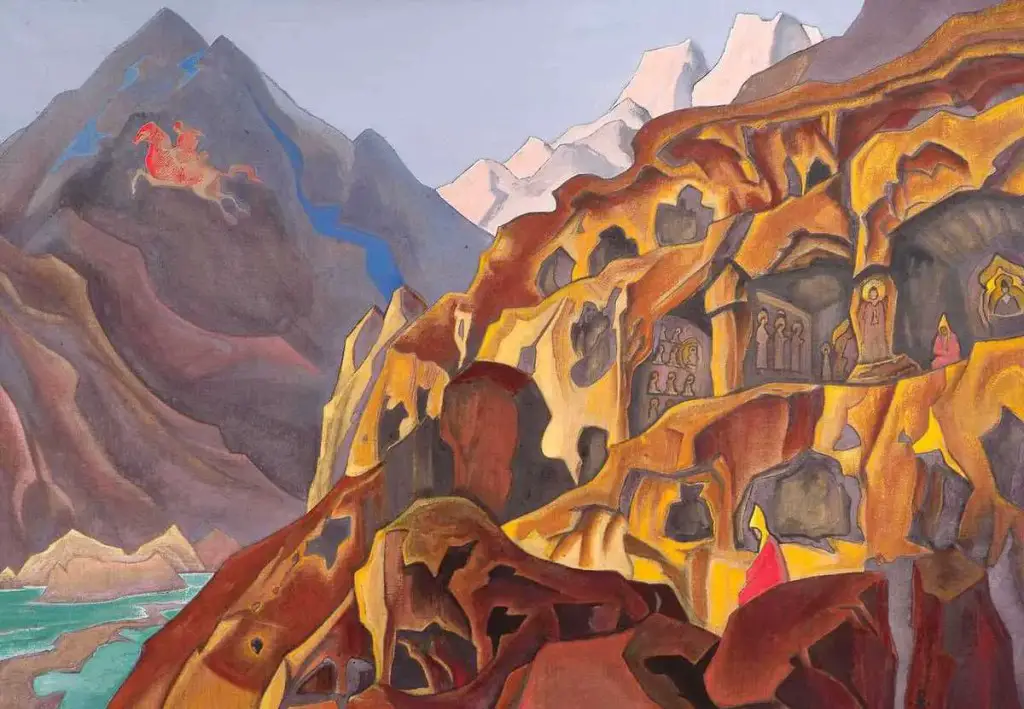
In the XNUMXth century, a description of a monk's journey was handwritten among the Old Believers. The text begins with a precise description of the way to the Urals, and then indicates the journey through Siberia, through the Gobi desert and China towards the ocean, towards Belovodye. That country, like a paradise, is the homeland of Orthodox Christians, and there is no persecution for the faith, where there can be no Antichrist, it is also a place where true Christians live and where there are up to forty Russian churches. This legend suggests the tradition of the spread of Christianity in Central Asia, China, India, Ceylon and Mongolia from the third century due to the Manichaeans and a later, in the XNUMXth century, ai Nestorians. These legends flourished in a country, where there is a true Orthodox church, until the Moscow state began the persecution of the Old Believers. In the Altai, Roerich says, despite all the difficulties, persecutions and difficulties, the Old Believers kept an Icon and a Book that had passed from hand to hand, from generation to generation, hidden from prying eyes. The Old Believers had a special reverence for the icon. The Old Believer's house where Roerich lived now bears a plaque in honor of the artist's stay.
The Old Believers, met by Roerich in the Altai, told him of people who made the legendary journey to Belovodye. Those of them who were best trained in the spiritual field were invited to stay in that sacred place, the others were forbidden, and they returned to their homes.
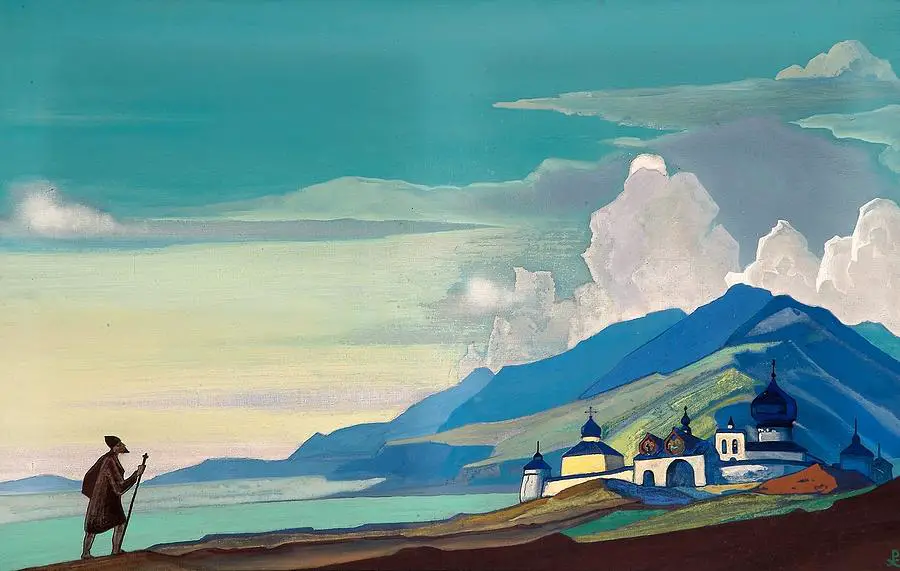
N. Roerich in a painting from 1933 depicts a pilgrim who sets out towards a mystical place: a man with a cane and a sack on his shoulders, walking towards a group of Russian Orthodox churches, located on the edge of a sea or lake. Is he one of the few who has found the city illuminated and who has now returned to tell the wonders of him? Roerich wrote that the Old Believers who fled to Altai from different regions of Russia also brought with them the legends of their old homeland concerning the Chuds.
In the Altai mountains, in the beautiful valley of Uimon, in the highlands, a venerable Old Believer (Starover) told me: "I will prove to you that the history of the Chud, the people who live within the Earth, is not only a figment of the imagination. ! I will lead you to the entrance of this subterranean kingdom "[...] We approached a small stony hill and, proud, he pointed to me, “Here we are: here is the entrance to the great underground kingdom. When the Chuds entered the underground passages, they closed the entrance with stones. Right now we are right next to the sacred entrance. "

Attracted and fascinated by the majesty and beauty of the mountains, Roerich was also intrigued by the series of underground tunnels and caves. Indeed, in the symbolic language of his paintings, esoteric wisdom is most often revealed in one of these two locations: far above the earth, on the peaks of high mountains, or deep under the earth, in hidden underground chambers and out of sight of the man. One of the legends that the Altai had most interested Roerich was the story of a vast tangle of honeycomb tunnels and the subterranean realms beneath the mountains. Roerich writes: “… with passages through splendid ice caves under the earth, few deserving people even in this life have reached the holy place”. In the Altai mountains there is therefore an entrance to the underground kingdom and to reach the mythical Shamballa.
Csoma de Koros, a Hungarian philologist [5], provided the geographical bearings to reach Shamballa in 45-50 degrees north latitude. Also the Russian general and explorer Nikolaj M. Prjevalsky, on the basis of an ancient monastic document, which he consulted, provided the longitude for Shambhala at 88 degrees [6]. These two coordinates situate the territory of Shambhala slightly east of the Altai Mountains, and precisely, where Roerich's expeditions ventured on numerous occasions. The Altai is like the vestibule, the gate of Shambhala to the Himalayas, the place that tradition calls Belovodye. The journey to Belovodye is described as follows: “From here, we go towards Irtys and Argon. After a difficult journey between rivers, if you don't lose your way, you will arrive at the salt lakes ”. This path is very dangerous! Many people have already died, but if you choose the right time, you will be able to cross these dangerous places. Then you come to the Bogogorsh mountain. From here, an even more dangerous path for Kokushi begins. After, take the path on Ergor itself and follow it down to the snow land. Here, in the highest of the mountains, there is a sacred valley. This is Belovodye ”. Roerich points out that that particular road leads to Tibet.
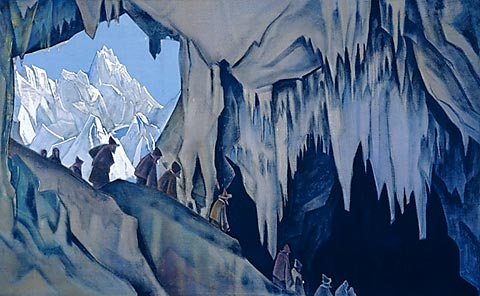
Note:
[1] In the Tsarist period the Altai was known as Oirot, Oirat
[2] http://www.roerich.kz/pakt.htm
[3] cit. N. Roerich, Heart of Asia
[4] cit. E. Siragusa, Journey to the Sacred Kingdom
[5] Csoma de Kòròs, got all his information from the red beret lamas after spending four years with them
in a Tibetan monastery, however, he never went to the Gelupka, the yellow caps
[6] NM Prjevalsky, Mongolia, London 1876, p. 63

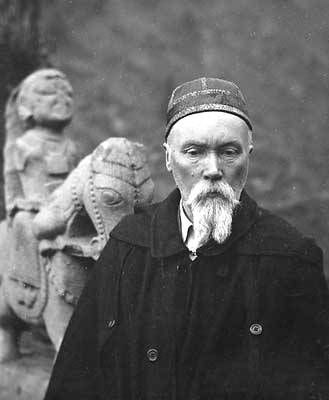
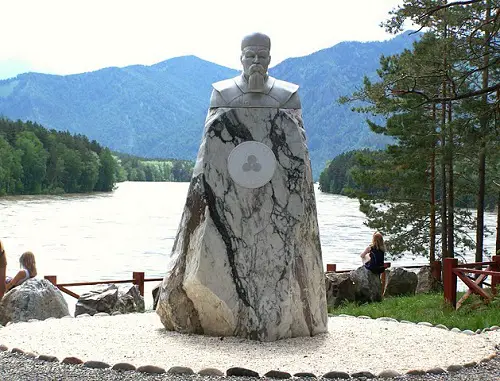
A comment on "The Altaic exploration of Nicholas Roerich in search of Belovodye, "the Land of the Living Gods""